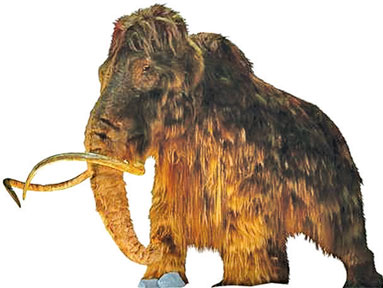Woolly mammoths became extinct because of climate change, not
hunting
DNA research reveals dynamic populations of the giant animals,
showing numbers plummeted at the end of the last ice age
DNA research on frozen woolly mammoths has found evidence which
suggests climate change had a far more significant impact on the
animals' extinction than previously thought.
Mammoths are among the best-researched of the former inhabitants of
our planet, and their abundance in fossil records and high-quality
samples had previously suggested the existence of a large and stable
population up until the point they clashed with human hunters.
 Research published by the Royal Society, however, shows that was not
the case, with mammoth numbers waxing and waning massively between
favourable ice ages - known as glacial - and tougher warm periods -
known as interglacial. Research published by the Royal Society, however, shows that was not
the case, with mammoth numbers waxing and waning massively between
favourable ice ages - known as glacial - and tougher warm periods -
known as interglacial.
During the world's colder periods, millions of mammoths spread out
across frosty tundra in mainland Europe, Siberia, and North America.
Yet according to the report the last interglacial, around 120,000
years ago, was characterised by a climate "at least as warm as today",
and with sea levels "as high as, or even higher than that at present".
By analysing the variation in DNA from different regions, scientists
can show that populations scattered into isolated, northern strongholds,
and numbers plummeted to the tens of thousands.
While they were then able to recover and repopulate wider areas
during the last ice age, the cycle repeated itself some 14,000 years ago
when the world warmed again.
The report said: "It thus seems likely that environmental changes
played a significant role in shaping the woolly mammoth's demographic
history, with warm periods restricting the amount of available habitat
and cold periods leading to population expansions."
Scientists leading the research from the Swedish Museum of Natural
History stressed that the extinction of an animal was usually down to a
combination of factors, and that while the new study reveals
unprecedented details about how mammoth numbers got to perilously low
levels, it does not show why they died out altogether.
It has previously been suggested that humans, hunting the animals for
food, furs and tusks, delivered the final blow in wiping mammoths out.
But there has been no scientific data collected to back this theory.
Lead researcher Dr Love Dalen told the BBC: "The picture that seems
to be emerging is that they were a fairly dynamic species that went
through local extinctions, expansions and migrations. It is quite
exciting that so much was going on."
- The Independent
|


